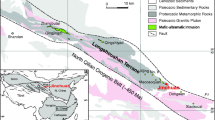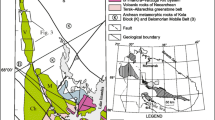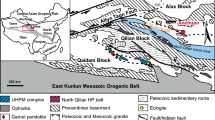Abstract
Ongoing underground exploration in the giant Jinchuan Ni-Cu sulfide deposit in western China is beginning to emphasize the potential for Cu-, Pt-, and Pd-rich sulfide ores that may have formed by sulfide liquid fractionation. The success of such an effort relies on whether or not fractional crystallization of sulfide occurred in the Jinchuan system. In this paper, we used available PGE data to evaluate such a process. We found that about two thirds of the 126 samples analyzed to date exhibit significant decoupling not only between Pt and Pd but also between Ru, Rh, and Ir. The best explanation for the decoupling is postmagmatic hydrothermal alteration, which affected not only silicates but also sulfides. The effects of postmagmatic alteration must be considered when using metal and isotopic ratios to evaluate primary mineralization. PGE variations in the remaining one third of the samples with Ir/(Ir + Ru) = 0.3–0.7, Ir/(Ir + Rh) = 0.4–0.8, and Pt/(Pt + Pd) = 0.3–0.7 indicate variable R-factors within individual ore bodies as well as the entire deposit, consistent with the interpretation that multiple sulfide-bearing magmas from depth were involved in the formation of the Jinchuan deposit. The mantle-normalized PGE patterns of the least-altered samples from the Jinchuan deposit are similar to the picrite-related Pechenga Ni-Cu sulfide deposit in Russia. PGE variations that can be related to sulfide liquid fractionation are observed in orebody-1 and orebody-24 but not in orebody-2 at Jinchuan. Exploration for Cu-, Pt-, and Pd-rich sulfide ores that may have been expelled into fractures in the footwalls of orebody-1 and orebody-24 appears to be justified.









Similar content being viewed by others
References
Barnes SJ, Tang ZL (1999) Chrome spinel from the Jinchuan Ni-Cu sulfide deposit, Gansu province, People’s Republic of China. Econ Geol 94:343–356
Barnes S-J, Maier WD (1999) The fractionation of Ni, Cu, and the noble metals in silicate and sulphide liquids. Geol Assoc Can Short Course Notes 13:69–106
Barnes S-J, Lightfoot PC (2005) Formation of magmatic nickel-sulfide ore deposits and processses affecting their copper and platinum-group element contents. In: Hedenquist JW, Thompson JFH, Goldfarb RJ, Richards JP (eds) Economic geology, 100th anniversary volume:179–213
Barnes S-J, Makovicky E, Karup-Moller S, Makovicky M, Rose-Hansen J (1997) Partition coefficients for Ni, Cu, Pd, Pt, Rh and Ir between monosulphide solid solution and sulphide liquid and the implications for the formation of compositionally zoned Ni-Cu sulphide bodies by fractional crystallization of sulphide liquid. Can J Earth Sci 34:366–374
Barnes S-J, Melehik V, Sokolov SV (2001) The composition and mode of formation of the Pechenga Nickel Deposits, Kola Peninsular, Northwestern Russia. Can Mineral 39:447–472
Bezmen NS, Asif M, Brugmann GE, Romanenko IM, Naldrett AJ (1994) Experimental determinations of sulfide-silicate partitioning of PGE and Au. Geochim Cosmochim Acta 58:1251–1260
Campbell IH, Naldrett AJ, (1979) The influence of silicate:sulfide ratios on the geochemistry of magmatic sulfides. Econ Geol 74:1503–1505
Chai G, Naldrett AJ (1992a) Characteristics of Ni-Cu-PGE mineralization and genesis of the Jinchuan deposit, northwest China. Econ Geol 87:1475–1495
Chai G, Naldrett AJ (1992b) The Jinchuan ultramafic intrusion: cumulate of a high-MgO basaltic magma. J Petrol 33:277–303
Chai G, Naldrett AJ, Rucklidge JC (1993) In suit quantitative analyses for PGE and Au in sulfide minerals of the Jinchuan Ni-Cu deposit by accelerator mass spectrometry. Can Mineral 33:277–303
Crocket JH, Fleet ME, Stone WE (1992) Experimental partitioning of osmium, iridium and gold between basalt melt and sulphide liquid at 1300°C. Aust J Earth Sci 39:427–432
De Waal SA, Xu ZH, Li C, Mouri H (2004) Emplacement of viscious mushes in the Jinchuan ultramafic intrusion, western China. Can Mineral 42:371–392
Fleet ME, Stone WE (1991) Partitioning of platinum-group elements and Au in the Fe–Ni–S system and their fractionation in nature. Geochim Cosmochim Acta 55:245–253
Fleet ME, Chryssoulis SL, Stone WE, Weisener CG (1993) Partitioning of platinum-group elements and Au in the Fe–Ni–Cu–S system: Experiments on the fractional crystallization of sulphide melt. Contrib Mineral Petrol 115:36–44
Fleet ME, Crocket JH, Liu M, Stone WE (1999) Laboratory partitioning of platinum-group elements (PGE) and gold with application to magmatic sulfide-PGE deposits. Lithos 47:127–142
Lehmann J, Arndt N, Windley B, Zhou M-F, Wang CY, Harris C (2007) Field relationships and geochemical constraints on the emplacement of the Jinchuan intrusion and its Ni-Cu-PGE sulfide deposit, Gansu, China. Econ Geol 102:75–94
Li C, Naldrett AJ, Coats CJA, Johannessen P (1992) Platinum, palladium, gold, and copper-rich stringers at the Strathcona Mine, Sudbury: their enrichment by fractionation of a sulfide Liquid. Econ Geol 87:1584–1598
Li C, Barnes S-J, Mackovicky E, Karup-Moller S, Makovicky M, Rose-Hansen J (1996) Partitioning of nickel, copper, iridium, rhodium, platinum, and palladium between monosulfide solid solution and sulfide liquid: effects of temperature and composition. Geochim Cosmochim Acta 60:1231–1238
Li C, Xu ZH, de Waal SA, Ripley EM, Maier WD (2004) Compositional variations of olivine from the Jinchuan Ni-Cu sulfide deposit, western China: Implications for ore genesis. Miner Depos 39:159–172
Li XH, Su L, Chung S-L, Li ZX, Liu Y, Song B, Liu DY (2005) Formation of the Jinchuan ultramafic intrusion and the world’s third largest Ni-Cu sulfide deposit: associated with the ×825Ma south China mantle plume? Geochemistry Geophysics Geosystems 6:16–32
McDonough WW, Sun S-S (1995) The composition of the Earth. Chem Geol 120:223–253
Mungall JE, Andrews DRA, Cabri LJ, Sylvester PJ, Tubrett M (2005) Partitioning of Cu, Ni, Au, and platinum-group elements between monosulfide solid solution and sulfide melt under controlled oxygen and sulfur fugacities. Geochim Cosmochim Acta 69:4349–4360
Naldrett AJ (2004) Magmatic sulfide deposits: Geology, geochemistry and exploration. Berlin, Springer, p 727
Naldrett AJ, Duke JM (1980) Platinum metals in magmatic sulfide ores. Science 208:1417–1428
Naldrett AJ, Innes DC, Sowa J, Gorton M (1982) Compositional variations within and between five Sudbury ore deposits. Econ Geol 77:1519–1534
Peach CL, Mathez EA, Keays RR, Reeves SJ (1994) Experimentally determined sulfide melt-silicate melt partition coefficients for iridium and palladium. Chem Geol 117:361–377
Qi L, Hu J, Grégoire DC (2000) Determination of trace elements in granites by inductively coupled plasma mass spectrometry. Talanta 51:507–513
Qi L, Zhou MF, Wang CY (2004) Determination of low concentrations of platinum group elements in geological samples by ID-ICP-MS. J Anal At Spectrom 19:1335–1339
Ripley EM, Sarkar A, Li C (2005) Mineralogic and stable isotope studies of hydrothermal alteration at the Jinchuan Ni-Cu deposit, China. Econ Geol 100:1349–1361
Song XY, Zhou MF, Wang Y, Qi L (2006) Role of crustal contamination in the formation of the Jinchuan Ni-Cu-PGE sulfide deposit, NW China. Int Geol Rev 48:1113–1132
Stone WE, Crocket JH, Fleet ME (1990) Partitioning of palladium, iridium, platinum and gold between sulfide liquid and basaltic melt at 1200°C. Geochim Cosmochim Acta 54:2341–2433
Tang ZL (1993) Genetic model of the Jinchuan nickel–copper deposit. Geol Assoc Can Special Paper 40:389–401
Yang XZ, Ishihara S, Zhao DH (2006) Genesis of the Jinchuan PGE deposit, China: evidence from fluid inclusions, mineralogy and geochemistry of precious elements. Mineral Petrol 86:109–128
Yang S, Qu W, Tian Y, Chen J, Yang G, Du A (2008) Origin of the inconsistent apparent Re-Os ages of the Jinchuan Ni–Cu sulfide ore deposit: China: Post-segregation diffusion of Os. Chem Geol 247:401–418
Zientek ML, Likhachev AP, Kunilov VE, Barnes S-J, Meier AL, Carlson RR, Briggs PH, Fries TL, Adrian BM (1994) Cumulus processes and the composition of magmatic ore deposits: examples from the Talnakh district, Russia. Ont Geol Surv Spec Publ 5:373–392
Acknowledgments
We are grateful to the Jinchuan Nickel Company for permission of underground sampling, and to Yulong Tian, Jianpu Jiang, and Yushan Wang of the Company for field assistance. Critical comments from Associate Editor Dr. Peter Lightfoot, reviewer Dr. Steve Barnes, and an anonymous reviewer greatly improved the manuscript. This research was supported by the Natural Science Foundation of China (grants 40472051 and 40534020) and Project-111 from the Ministry of Education of China (B07011).
Author information
Authors and Affiliations
Corresponding author
Additional information
Editorial handling: P. Lightfoot
Rights and permissions
About this article
Cite this article
Su, S., Li, C., Zhou, MF. et al. Controls on variations of platinum-group element concentrations in the sulfide ores of the Jinchuan Ni-Cu deposit, western China. Miner Deposita 43, 609–622 (2008). https://doi.org/10.1007/s00126-008-0186-2
Received:
Accepted:
Published:
Issue Date:
DOI: https://doi.org/10.1007/s00126-008-0186-2




